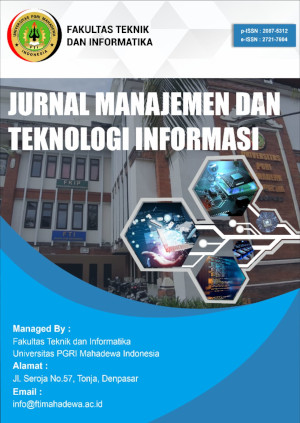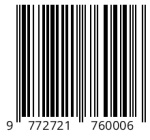DOKUMENTASI PENGGUNA SISTEM SKRINING “ANAK TANGGUH”, MEDIA SKRINING DIGITAL AUTISME BERBASIS M-CHAT-R/F DI INDONESIA
DOI:
https://doi.org/10.59819/jmti.v15i2.5316Keywords:
User Documentation, Digital skrining, Autisme, Skrining Autisme, M-CHAT-R/FAbstract
There is an increasing prevalence of Autism among Indonesian children. However, limited access, cost, and the lack of Indonesian-language screening tools present significant challenges for parents in the early detection of children with autism. A web-based digital system known as the "Sistem Skrining Anak Tangguh", has been developed in Indonesia. This system employs the M-CHAT-R/F (Modified Checklist for Autism in Toddlers, Revised with Follow-Up) method, which is a well-established tool for autism screening. The potential impact of this system is significant, as it could provide a comprehensive and efficient screening tool for autism in Indonesia. The system has been designed to offer all of its functions in Indonesian-language to increase accessibility and understanding among Indonesians. The system is accessible via web browser, enabling parents to conduct screening independently, at any time and from any location. However, a search for user documentation on the website has not yielded any results. The objective of this research project is to produce user documentation for the Sistem Skrining Anak Tangguh. The present user documentation is expected to engender a number of benefits. It is anticipated that an increase in the utilisation of the screening site will result in enhanced efficacy of its usage by users. This is expected to evolve into a comprehensive solution that will broaden the scope of early autism screening in Indonesia.
Downloads
References
Administrator. (n.d.). Tenaga Ahli Autisme di Indonesia Masih Terbatas - Universitas Gadjah Mada - ugm.ac.id.
Ahsan, K. (2025). Autism spectrum disorder: A global public health challenge. Mugda Medical College Journal, 8(1), 1-2.
Arini Nur Rohmah, e. a. (2025). Anak_tangguh - screening.anaktangguh.com.
autismspeaks.org. (2009). Autismspeaks.org.
Brooke, J., et al. (1996). Sus-a quick and dirty usability scale. Usability evaluation in industry, 189(194), 4-7.
Cook, C., & Visconti, M. (1994). Documentation is important. CrossTalk, 7(11), 26-30.
Doll, W. J., & Torkzadeh, G. (1987). The quality of user documentation. Information & management, 12(2), 73-78.
do Nascimento Marques, L., Murray, C., Fortaleza, L., Landeira-Fernandez, J., & Anunciação, L. (2025). Psychometric evaluation of two adult autism screening tools in brazil. Autism Research.
Gould, J. D., & Lewis, C. (1985). Designing for usability: Key principles and what designers think. Communications of the ACM, 28(3), 300-311.
Hasnita, E., & Hidayati, T. R. (2017). Terapi okupasi perkembangan motorik halus anak autisme. Jurnal Ipteks Terapan, 9(1).
Hong Liang Cai, I. A. L., David H Hareva. (2022). User experience dan antarmuka pengguna berbasis audio pada aplikasi blindness guidance. Format : Jurnal Ilmiah Teknik Informatika, 11(1).
Indah, T. R. P. (2025). Informasi terkait autisme yang perlu diketahui.
of Mental Health, N. I. (Revised 2025). Autism spectrum disorder. U.S. Department of Health; Human Services, National Institutes of Health.
Okoye, C., Obialo-Ibeawuchi, C. M., Obajeun, O. A., Sarwar, S., Tawfik, C., Waleed, M. S., Wasim, A. U., Mohamoud, I., Afolayan, A. Y., & Mbaezue, R. N. (2023). Early diagnosis of autism spectrum disorder: A review and analysis of the risks and benefits. Cureus, 15(8).
Online Community - autism.org.uk. (n.d.).
Robins, D. L., Fein, D., & Barton, M. (2009). Modified checklist for autism in toddlers, revised, with follow-up (m-chat-r/f) tm. LineageN.
Sagita, R. F., Suryawan, A., & Anis, W. (2021). Karakteristik penerimaan orang tua dalam menghadapi diagnosis autisme anak characteristic of parents's acceptance in getting child diagnosis as autism. Indonesian Midwifery and Health Sciences Journal, 5(2), 186-197.
Sano, R., Hizume, M., Sukandar, R., Corporal, L. L., Inoue, M., Zobritania, M., Kato, T., & Nagatani, A. 2024). Kondisi terkini dan isu kebijakan layanan kesehatan bagi penyandang disabilitas perkembangan di asia tenggara.
Sidabutar, B. E. E., Neolaka, A., & Simbolon, B. (2020). Peran orangtua dalam menangani anak autisme. Jurnal Manajemen Pendidikan, 9(1), 61-87.
tempo.co. (2023). Jumlah Anak Autis Meningkat, Diduga Salah Satu Penyebab karena BPA.
Tentang Anak - Ahlinya Kebutuhan si Kecil - tentanganak.com. (n.d.).
Zeidan, J., Fombonne, E., Scorah, J., Ibrahim, A., Durkin, M. S., Saxena, S., Yusuf, A., Shih, A., & Elsabbagh, M. (2022). Global prevalence of autism: A systematic review update. Autism research, 15(5), 778-790.
Downloads
Published
Issue
Section
License
Copyright (c) 2025 Arini Nur Rohmah, Aji Ari Adam, Prilya Shanty Adrianie, Ariefin Nur Hidayat, Amri Zadi Hudaya, Galardhia Zain Azzahra, Naila Khairunnisa, Dedi Gunawan, Yusuf Sulistyo Nugroho

This work is licensed under a Creative Commons Attribution-ShareAlike 4.0 International License.
Authors who publish with the Jurnal Manajemen dan Teknologi Informasi agree to the following terms:
1. Authors retain copyright and grant the journal the right of first publication with the work simultaneously licensed under a Creative Commons Attribution License (CC BY-SA 4.0) that allows others to share the work with an acknowledgment of the work's authorship and initial publication in this journal.
2. Authors are able to enter into separate, additional contractual arrangements for the non-exclusive distribution of the journal's published version of the work (e.g., post it to an institutional repository or publish it in a book), with an acknowledgment of its initial publication in this journal.
3. Authors are permitted and encouraged to post their work online (e.g., in institutional repositories or on their website) prior to and during the submission process, as it can lead to productive exchanges, as well as earlier and greater citation of published work. (See The Effect of Open Access) .





















